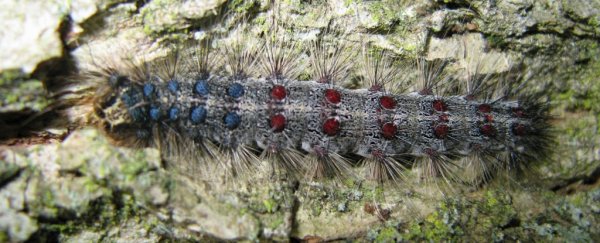An outbreak of gypsy moth caterpillars is currently raging across the woodlands of Massachusetts, chewing through over 100,000 acres of land between Quabbin Reservoir and Cape Cod.
This is the worst outbreak of caterpillars in the region since 1981, when the small creatures destroyed over 200,000 acres of land in the state by eating nearly all of the leaves off oak, cherry, and pine trees.
That might not sound like such a big deal, because caterpillars are kinda cute, right? Well, according to the US Department of Agriculture, gypsy moths (Lymantria dispar) are one of the biggest pests in the Eastern US, defoliating nearly 1 million acres of forest in the region every year since 1980.
This damage typically occurs when gypsy moths are in their larval (or caterpillar) stage, which typically starts around May. These newly hatched larvae use strands of silk to glide on wind gusts, spreading themselves all over forests where they continuously munch on leaves until they enter their pupa stage a few months later.
That's what the people of Massachusetts are in the middle of right now. While it's a bit hard to imagine what an infestation of caterpillars looks like for those not living in the region, reports have indicated that the woodlands are looking a lot like something out of a horror movie with caterpillars actually raining down on people and nearly covering whole houses.
"One part of the front of the house was solid black," Essex resident Margaret Lasko told Morgan Hines from Hartford Courant. "It was so gross."
"It's just a gypsy moth bloodbath out here," campsite owner Jeff Kilburn told Michael Levenson from The Boston Globe. "It's like all-out war. They have invaded and they are taking no prisoners."
You can see the damage below:
The worst part about all of this is that the gypsy moth was never supposed to live in North America at all. In fact, all of the gypsy moth caterpillar infestations can be traced back to a single, unnamed scientist's window sill.
According to a report by researchers at the University of Kentucky, America's gypsy moth problem began in 1869, when a French scientist was experimenting with gypsy moths on his window sill, trying to see if there was a viable silkworm market in the US.
One day, wind blew the caterpillars out of the window, and a few years later in 1889, the first major infestation occurred in the region. They've occurred every decade since.
Things changed in 1989 when a fungal pathogen began to take root, all on its own, on the trees the caterpillars call home, killing off many of the larvae before they had a chance to create a boom.
This led to a significant decrease in outbreaks, causing many to believe that nature had sort of evened itself out, but that sadly wasn't the case, though, because last year, the region experienced a pretty extensive drought throughout May - the time of year when the fungus is most active, spreading from tree to tree.
This caused a significant amount of larva to survive, leading to an increased amount of caterpillars last year and a shocking amount this year.
"The fungus Entomophaga maimaiga, which is present in the forest litter, needs rains to infect the commuting stages of the caterpillar that travel up and down the trees," entomologist Gale Ridge, from The Connecticut Agricultural Experiment Station (CAES), told Hartford Courant. "If the rains do not arrive, the caterpillars are not infected and they mature into adults for reproduction."
In other words, the drought last year has led to a snowballing effect, causing bigger and bigger infestations over the last two years. The bad news is that this trend will likely continue. In fact, next year might be even worse than this year.
"Connecticut is potentially facing a huge gypsy moth infestation next summer," chief CAES scientist Kirby Stafford said. "If you already have trees that have been defoliated and stripped you may need to go ahead and think about doing some control on the caterpillars next year. You probably will not be able to rely on fungus. Homeowners may have to spray to protect trees early next summer."
The gypsy moth caterpillars are only one example of an invasive species in the US. In fact, one of the most deadly invasive species is tumbleweed.
Yes, the very same round, bouncy bush that you probably attribute to every Western film ever is actually an invasive species that can easily pile up and create vicious wildfires in California, according to a report issued back in April by researchers from the University of Arizona.
There is so far no word on what actions will be taken to curb the spread of the gypsy moth infestation, though hopefully a solution presents itself before the idyllic forests of the American Northeast are completely turned into frass (that's a technical work for caterpillar poop. You're welcome).
